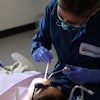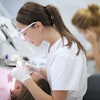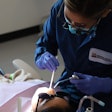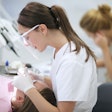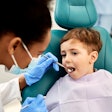
Dental therapy can improve access to high-quality, safe, and cost-effective care -- and, eventually, boost oral health equity, according to Dr. Frank Catalanotto. He spoke at the June 22 "Behind the PubMed Citation" talk presented by the University of Pennsylvania's Leon Levy Dental Medicine Library.
In a broken healthcare system that leaves so many without dental care access, dental therapists can assist in leveling the playing field, said Catalanotto, a professor in the department of community dentistry and behavioral science at the University of Florida College of Dentistry. He was also one of the authors of the "Dental Therapists' Impact on Access to Care and Oral Health Equity" report published in the May issue of Compendium of Continuing Education in Dentistry.
"I started to view dental therapy as a tool just like community water fluoridation and minimally invasive dentistry," Catalanotto said during the talk. "These are tools to help us improve oral health and, specifically, oral health equity."
Tremendous oral healthcare need
In December 2018, there were 5,863 dental health professional shortage areas designated by the U.S. Health Resources and Services Administration. These are geographic areas, populations, and facilities in which the need for dental services exceeds the number of dental care providers.
The shortage areas affect about 57.94 million people in the U.S., and for the designation to be removed, 10,635 dentists are needed. Also, approximately 190 million people in the U.S. cannot get regular access to dental care, Catalanotto said.
"Populations most in need of dental care receive the least," he added.
In 2009, Minnesota became the first state in the U.S. to authorize dental therapists. Since then, 11 other states, including Maine, Idaho, and Vermont, have followed suit. Adding dental therapists has made a major difference in these states, Catalanotto said.
At a nonprofit community dental organization in Minnesota, dentists were seeing more patients, providing more services, and producing higher relative value units and fees per treatment per day than in the years before dental therapists were added to the workforce, according to Catalanotto's analysis. In Alaska, adults and children in Alaska Native communities had lower rates of tooth extractions and higher rates of preventive care during a 10-year period when dental health aide therapists served more intensively, he noted.
The outcomes in Alaska and Minnesota could be why dental therapy legislation is gaining momentum across the country. Several other states, including Wisconsin, are considering similar legislation to add dental therapists to their oral health workforce. Oregon is a step away from authorizing dental therapists, with its bill (HB 2528) just awaiting the signature of Gov. Kate Brown.
Other routes to improvement
Despite the momentum, dental associations, including the ADA, oppose the authorization of dental therapists and have lobbied to prevent states from adding this new category of midlevel providers. The ADA has said the priority should be connecting underserved populations with dentists who are available to treat them, Catalanotto said. The organization believes improving access to care hinges on community health worker outreach and improved dental service funding under Medicaid.
Catalanotto called the ADA's idea of using community dental health coordinators to improve access to care a fair idea but said it did "nothing to help the problem." Coordinators can help patients with a lack of oral health literacy connect with dentists; however, they still must visit hospitals and pay for services, he emphasized.
"The ADA has committed dues money for this, but no data on the value of [coordinators] has been presented," Catalanotto said.
When it comes to improving access to oral health and reducing inequities, Catalanotto said several additional solutions should be explored, including integrating medical and dental care and improving the oral health literacy of the public, especially policymakers.
He also called for loan forgiveness to attract dentists to dental health professional shortage areas, better Medicaid reimbursement rates and fewer administrative hassles, and more safety net programs, including federally qualified health centers with sliding-scale fees.
Finally, "change restrictive dental practice acts to follow more direct access for dental hygienists and implementation of dental therapy," Catalanotto said.
Note: The opinions Catalanotto shared in this presentation are his own and do not necessarily represent the official viewpoints of any organization with which he is affiliated.


